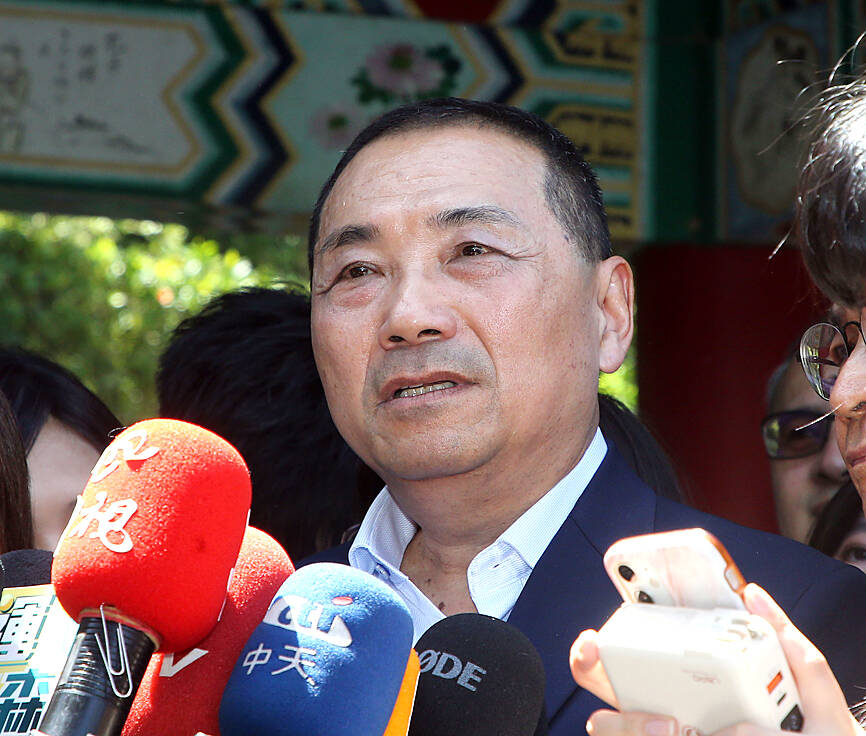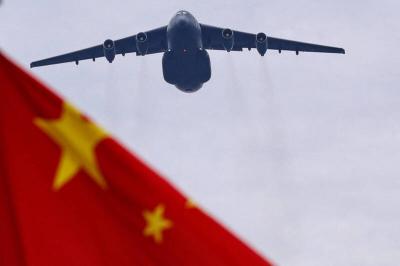New Taipei City Mayor Hou You-yi (侯友宜), who is the Chinese Nationalist Party’s (KMT) presidential candidate, on Monday said he would support a version of the so-called “1992 consensus” that conforms with the Republic of China (ROC) Constitution.
Hou was previously vague about his stance on the “1992 consensus.”
The “1992 consensus” — a term that former Mainland Affairs Council chairman Su Chi (蘇起) in 2006 admitted making up in 2000 — refers to a tacit understanding between the KMT and the Chinese Communist Party that both sides of the Taiwan Strait acknowledge that there is “one China,” with each side having its own interpretation of what “China” means.

Photo: CNA
He said he is against interpreting the “1992 consensus” as referring to “one country, two systems,” as done by the Democratic Progressive Party (DPP) and strongly opposes President Tsai Ing-wen’s (蔡英文) “stigmatization” of it.
Hou did not comment on criticism that he merely echoed the KMT’s long-held position of “one China, different interpretations” — which gives tacit freedom to Taipei and Beijing to come to separate conclusions as to what “China” means. Beijing has never formally endorsed this stance.
The DPP on Tuesday said that Hou’s “consensus” views “flew in the face of mainstream public opinion in Taiwan.”
Referencing a 2019 speech by Chinese President Xi Jinping (習近平), the DPP said that the “1992 consensus” and “one country, two systems” — an arrangement under which China agreed to rule Hong Kong and Macau, and has also proposed for Taiwan — are the same thing.
The speech referred to the “1992 consensus” as a political “foundation” to enable negotiations and exchanges, while “one country, two systems” was characterized as a “policy” and “plan” for achieving “peaceful reunification.”
The DPP has refused to accept the “1992 consensus” on the grounds that Beijing has never acknowledged the ROC’s existence and that agreeing to the “1992 consensus” would imply accepting China’s claim over Taiwan.

Beijing could eventually see a full amphibious invasion of Taiwan as the only "prudent" way to bring about unification, the US Department of Defense said in a newly released annual report to Congress. The Pentagon's "Annual Report to Congress: Military and Security Developments Involving the People's Republic of China 2025," was in many ways similar to last year’s report but reorganized the analysis of the options China has to take over Taiwan. Generally, according to the report, Chinese leaders view the People's Liberation Army's (PLA) capabilities for a Taiwan campaign as improving, but they remain uncertain about its readiness to successfully seize

Taiwan is getting a day off on Christmas for the first time in 25 years. The change comes after opposition parties passed a law earlier this year to add or restore five public holidays, including Constitution Day, which falls on today, Dec. 25. The day marks the 1947 adoption of the constitution of the Republic of China, as the government in Taipei is formally known. Back then the Chinese Nationalist Party (KMT) governed China from Nanjing. When the KMT, now an opposition party in Taiwan, passed the legislation on holidays, it said that they would help “commemorate the history of national development.” That

Taiwan has overtaken South Korea this year in per capita income for the first time in 23 years, IMF data showed. Per capita income is a nation’s GDP divided by the total population, used to compare average wealth levels across countries. Taiwan also beat Japan this year on per capita income, after surpassing it for the first time last year, US magazine Newsweek reported yesterday. Across Asia, Taiwan ranked fourth for per capita income at US$37,827 this year due to sustained economic growth, the report said. In the top three spots were Singapore, Macau and Hong Kong, it said. South

Snow fell on Yushan (Jade Mountain, 玉山) yesterday morning as a continental cold air mass sent temperatures below freezing on Taiwan’s tallest peak, the Central Weather Administration (CWA) said. Snowflakes were seen on Yushan’s north peak from 6:28am to 6:38am, but they did not fully cover the ground and no accumulation was recorded, the CWA said. As of 7:42am, the lowest temperature recorded across Taiwan was minus-5.5°C at Yushan’s Fengkou observatory and minus-4.7°C at the Yushan observatory, CWA data showed. On Hehuanshan (合歡山) in Nantou County, a low of 1.3°C was recorded at 6:39pm, when ice pellets fell at Songsyue Lodge (松雪樓), a